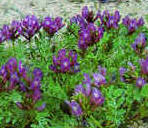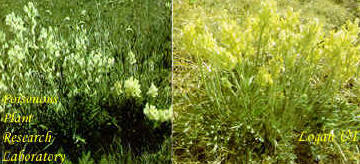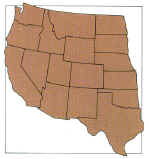|
 Locoweed gets its name from the Spanish word loco (crazy) which is how the abnormal behavior of poisoned animals has been described. This "locoed" behavior results from locoweed-induced neurologic damage. Most of the time, animals become depressed and lethargic. Although some of the toxic effects resolve after animals are removed from infested areas, the neurologic damage may be permanent. Within several weeks, most livestock recover and begin to improve condition. As neurologic signs may unpredictably recur, working animals, especially horses have a very poor prognosis as they are of little value as saddle or draft animals. With chronic locoweed poisoning, livestock become emaciated and wasted as animals lose the ability to find, prehend and utilize feed. Although some may die of starvation, most die from misadventure. Other direct losses from Locoweed gets its name from the Spanish word loco (crazy) which is how the abnormal behavior of poisoned animals has been described. This "locoed" behavior results from locoweed-induced neurologic damage. Most of the time, animals become depressed and lethargic. Although some of the toxic effects resolve after animals are removed from infested areas, the neurologic damage may be permanent. Within several weeks, most livestock recover and begin to improve condition. As neurologic signs may unpredictably recur, working animals, especially horses have a very poor prognosis as they are of little value as saddle or draft animals. With chronic locoweed poisoning, livestock become emaciated and wasted as animals lose the ability to find, prehend and utilize feed. Although some may die of starvation, most die from misadventure. Other direct losses from abortions, birth defects, increased neonatal death, and increased susceptibility to other infectious diseases may also be high. Locoweeds are relatively palatable during spring and fall when they are green and associated forage is dry or dormant. The dry senescent stalks and are also palatable during the winter. Animals can be forced to eat locoweed at other times if desirable forage is not available. Animals are more susceptible to locoweed poisoning after they have once been affected. abortions, birth defects, increased neonatal death, and increased susceptibility to other infectious diseases may also be high. Locoweeds are relatively palatable during spring and fall when they are green and associated forage is dry or dormant. The dry senescent stalks and are also palatable during the winter. Animals can be forced to eat locoweed at other times if desirable forage is not available. Animals are more susceptible to locoweed poisoning after they have once been affected.

The more common species include white point loco, woolly loco, spotted loco, and garboncillo. Loco is poisonous at all stages of growth. Plants are dangerous throughout the year, even when they have matured and dried. All plant parts are toxic.
Locoweed is found on foothills and semiarid regions. It grows in tufts or clumps, 8 to 30 cm high. Locoweed flowers resemble sweet peas. Blossoms may be blue, purple, yellow, or white. Each stem contains numerous leaves and a leaflet on its tip; leaves are pinnately compound.

Where and When It Grows
Locoweeds are commonly found on mountains, foothills, and plains and in semiarid desert regions. Growth starts in late fall, winter, or early spring, depending on locality, species, and moisture. Woolly loco is found from southwestern South Dakota south to Texas and New Mexico. White point loco grows from Montana, Idaho, and North Dakota south to Arizona, New Mexico, and Texas. Spotted loco grows from British Columbia to Mexico, and east to Colorado. Bigbend loco is native to the region of Texas for which it was named; it also occurs in southern New Mexico. Wooton loco grows in eastern Arizona, as well as in the same areas as Bigbend loco. Locoweeds are prolific seed producers and the seeds may remain viable in the soil 50 years or more.
How It Affects Livestock
Horses, cattle, sheep, goats, and wildlife (elk, deer, antelope) are poisoned by eating locoweed. Signs of poisoning appear after 2 to 3 weeks of continuous grazing on the plant. Locoweed has four principal effects on livestock. These are: (1) neurological damage; (2) emaciation; (3) reproductive dysfunction and abortion; and (4) congestive right heart failure when grazed at high elevations.
Signs and Lesions of Poisoning
- Depression
- Dull dry hair coat
- Eyes dull and staring
- Irregular gait or some loss of muscular control
- Weakness
- Some animals show extreme nervousness
- Loss of sense of direction
- Withdrawal from other animals
- Some animals develop inability to eat or drink
- Abortions are common; hydrops may occur in some cattle
- Skeletal malformations may occur
- Animal may become violent if stressed
- Reduced libido in males and altered estrous behavior in females
- Cessation of spermatogenesis and oogenesis
- Recumbency and death may follow prolonged consumption of locoweed Vacuolation
of neurons, renal tubular epithelium, hepatocytes, etc.
- Congestive heart failure when grazed at high elevations
How to Reduce Losses
Restrict access to locoweed during critical periods when the plant is more palatable than associated forages. Maintain conservative stocking rates to avoid forcing animals to consume locoweed when desirable forage becomes limited. Remove animals that begin eating locoweed to prevent intoxication and to keep them from influencing others to start eating locoweed. No treatments have been identified that are effective in reversing or minimizing locoweed poisoning.
Locoweed can be controlled by spraying actively growing or budding plants with clopyralid (20-30 gm ae/Ac), picloram (250 gm ai/Ac), and metsulfuron (30 gm ai/Ac). If plants are scattered, treatment of individual plants or patches may be practical. Follow precautions when handling herbicides.
|



 Locoweed gets its name from the Spanish word loco (crazy) which is how the abnormal behavior of poisoned animals has been described. This "locoed" behavior results from locoweed-induced neurologic damage. Most of the time, animals become depressed and lethargic. Although some of the toxic effects resolve after animals are removed from infested areas, the neurologic damage may be permanent. Within several weeks, most livestock recover and begin to improve condition. As neurologic signs may unpredictably recur, working animals, especially horses have a very poor prognosis as they are of little value as saddle or draft animals. With chronic locoweed poisoning, livestock become emaciated and wasted as animals lose the ability to find, prehend and utilize feed. Although some may die of starvation, most die from misadventure. Other direct losses from
Locoweed gets its name from the Spanish word loco (crazy) which is how the abnormal behavior of poisoned animals has been described. This "locoed" behavior results from locoweed-induced neurologic damage. Most of the time, animals become depressed and lethargic. Although some of the toxic effects resolve after animals are removed from infested areas, the neurologic damage may be permanent. Within several weeks, most livestock recover and begin to improve condition. As neurologic signs may unpredictably recur, working animals, especially horses have a very poor prognosis as they are of little value as saddle or draft animals. With chronic locoweed poisoning, livestock become emaciated and wasted as animals lose the ability to find, prehend and utilize feed. Although some may die of starvation, most die from misadventure. Other direct losses from abortions, birth defects, increased neonatal death, and increased susceptibility to other infectious diseases may also be high. Locoweeds are relatively palatable during spring and fall when they are green and associated forage is dry or dormant. The dry senescent stalks and are also palatable during the winter. Animals can be forced to eat locoweed at other times if desirable forage is not available. Animals are more susceptible to locoweed poisoning after they have once been affected.
abortions, birth defects, increased neonatal death, and increased susceptibility to other infectious diseases may also be high. Locoweeds are relatively palatable during spring and fall when they are green and associated forage is dry or dormant. The dry senescent stalks and are also palatable during the winter. Animals can be forced to eat locoweed at other times if desirable forage is not available. Animals are more susceptible to locoweed poisoning after they have once been affected.